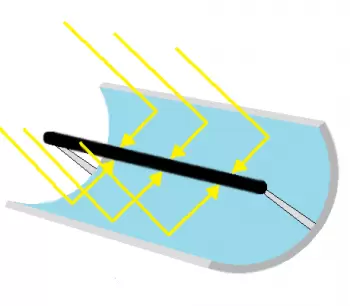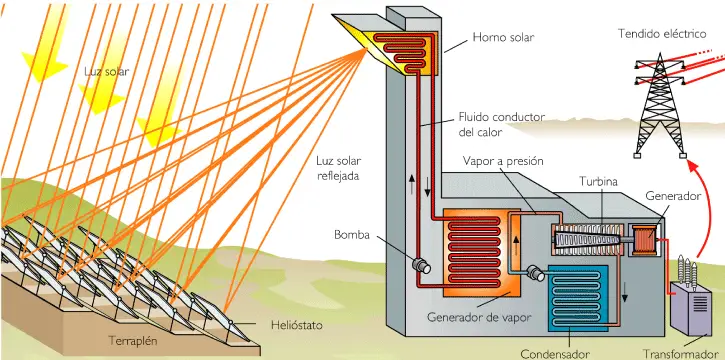
High-temperature solar thermal power plants are thermal power plants that concentrate solar energy to a focal point to generate electricity.
The operating temperature reached using this concentration technique is above 500 degrees Celsius—this amount of energy heat transfer fluid to produce steam using heat exchangers.
The energy source in a high-temperature solar power plant is solar radiation. Meanwhile, a conventional thermal power plant uses fossil fuels such as coal or gas.
The source of energy is the main difference between conventional thermal power plants, and then all types of thermoelectric plants work similarly:
-
Steam generated drives a steam turbine to obtain mechanical energy.
-
Mechanical energy drives power generators to get electrical energy.
Solar thermoelectric energy could supply 6% of global electricity demand in 2030 and reach 12% in 2050 if the right conditions are met.
It is a source of electricity that does not emit greenhouse gases. Moreover, it is perfectly adapted to various areas of the world with significant solar irradiation, such as southern Europe, North Africa, the Middle East, South Africa, India, China, the South of the USA, and Australia.
Types of high-temperature solar collectors
The technologies used in this type of facility are:
1. Parabolic trough solar collectors
The parabolic trough collectors concentrate solar radiation through parabolic-shaped mirrors in an absorbing pipe that passes through the parabola's axis. Inside this absorbent pipe, fluid is heated that can reach temperatures of up to 450ºC.
Depending on the solar use and the temperature to be reached, one type of fluid or another is used. For example, for a maximum temperature of 200 degrees Celsius, demineralized water or Ethylene Glycol can be used as working fluids, and synthetic oils are used for temperatures higher than 450 degrees Celsius.
It changes its position gradually depending on the Sun’s position to improve its efficiency.
2. Solar tower plants
 This solar thermal energy system is based on the concentration of solar radiation towards a point on a tower. It is also known as the central receiver system.
This solar thermal energy system is based on the concentration of solar radiation towards a point on a tower. It is also known as the central receiver system.
Tower systems are made up of a field of heliostats (2-axis mobile mirrors). Heliostats capture and concentrate solar radiation on a receiver installed on top of a central tower.
Since the sun’s position change constantly, the array of heliostats needs a tracking system to ensure to concentrate solar rays to the same focal point over time.
The operation of this type of renewable power plant is simple. First, the central solar receiver generates steam. The generated steam is later used to drive a steam turbine. Finally, thanks to the steam turbine, mechanical work is obtained in kinetic energy (a rotating shaft) that will be converted into electrical energy thanks to an electrical generator.
.
3. Parabolic discs
Parabolic disks are systems concentrating solar energy at a point where the solar receiver is located and a Stirling engine or a microturbine coupled to an alternator.
The fluid in the receiver is heated to temperatures of more than 750 degrees Celsius, thus obtaining specific heat energy. The thermal energy obtained is used by the Stirling engine or the microturbine to produce electricity.
A Stirling engine is an external combustion engine, which means that the energy supply can be made through concentrated solar energy. An alternator coupled to the Stirling engine takes advantage of the motion generated by the engine to produce electrical power. The electricity generated by this renewable resource can be connected to the electricity grid for sale or, in most cases, used for direct consumption.
This technology is still under study and is still less profitable than that of a tower or parabolic mirrors.
.
4. Linear Fresnel receivers
Linear Fresnel reflectors are a solar radiation concentration system similar to parabolic trough mirrors. In this case, these linear solar collectors carry regular flat mirrors and simulate the curvature of curved trough mirrors (more expensive) by varying the angle of each row with a single tracking axis.
The main advantage of the Fresnel linear receiver system is its simple installation and its low cost. However, its efficiency is lower than the Parabolic Cylinder Collector (CCP) technology.
.
World's largest thermal solar plants
1. Ivanpah. 392 MW. USA
Three huge solar farms in the middle of the Mojave desert, shared by the states of Nevada and California, make up the Ivanpah complex. It is the world's largest solar thermal plant, occupying an area of 13 square kilometers just 60 kilometers south of Las Vegas.
Its three 139-meter-high towers and more than 300,000 mirrors can produce 392 MW, a clean supply equivalent to reducing 400,000 tons of CO2 annually.
2. Solar Energy Generation Systems (SEGS). 354 MW. USA
Solar Power Generation Systems (SEGS) is currently the world's largest operating solar power plant. We can find it in the Mojave Desert in California, United States. Now, it has an installed capacity of 354 MW and generates 662 GWh of energy per year.
3. Sunshine. 280MW. USA
Solana Generating Station is a solar thermal plant near Gila Bend, Arizona, about 70 miles (110 km) southwest of Phoenix, completed in 2013. It was the largest parabolic trough plant with molten salt storage when commissioned. It has a total capacity of 280 MW gross from two 140 MW (net 125 MW) steam turbine generators.
The plant can supply 70,000 homes while avoiding about 475,000 tons of CO2 annually.
The plant uses concentrating solar power (CSP) and covers an area of 780 hectares.
4. MojaveSolar. 280MW. USA
Mojave Solar plant has a capacity of 280 MW located in the Mojave desert, near Barstow (California, USA).
Mojave Solar produces clean energy than can supply power for about 91,000 homes in California. In addition, it will prevent the emission of nearly 223,440 tons of CO2 into the atmosphere yearly.
Electricity generated in the Mojave is supplied to Pacific Gas & Electric Company for 25 years under an existing power purchase agreement (PPA). The project also contributes to California's goal of achieving 33% of total electricity production from renewable sources by 2020, according to the department of energy.
5. Genesis. 250MW. USA
The Genesis Solar Power Project is a Parabolic Trough Solar Power (CSP) plant with 250 MW of capacity. It is in the Mojave Desert on a 2,000-acre Bureau of Land Management tract in eastern Washington County.
The solar power plant has two sections of 125 MW (140 MW gross) and covers an area of 550 hectares. The plant has a production capacity of 560 GWh per year, the production that is supplied to Pacific Gas & Electric through a long-term power purchase agreement.